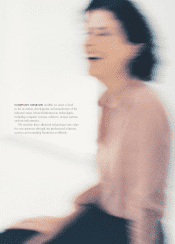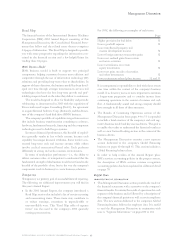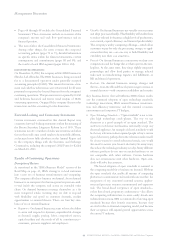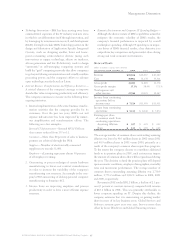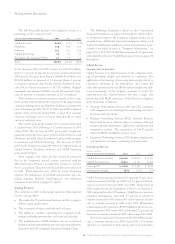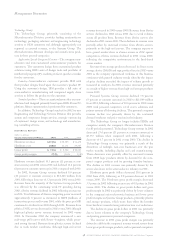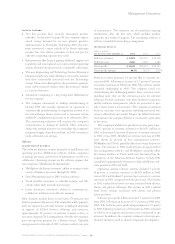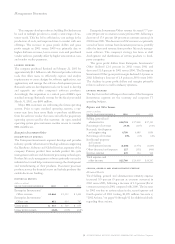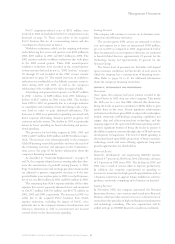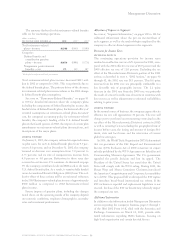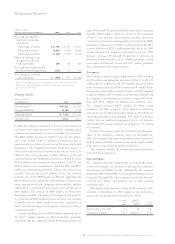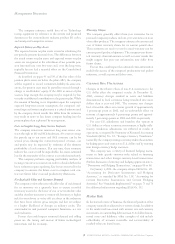IBM 2002 Annual Report Download - page 51
Download and view the complete annual report
Please find page 51 of the 2002 IBM annual report below. You can navigate through the pages in the report by either clicking on the pages listed below, or by using the keyword search tool below to find specific information within the annual report.
looking forward
■
Two key product lines recently announced product
refreshes. As discussed on page 48, the company experi-
enced strong demand for its new pSeries products
announcement in November. In January 2003, the com-
pany announced a major refresh of its iSeries midrange
product line that allows customers to buy and pay for
only the computing capacity they need.
■
Indications are that Linux is gaining additional support and
popularity and is recognized as an open standard operating
system. Systems Group servers are compatible with Linux.
■
The new Engineering and Technology Services Division is
bringing entirely new value offerings to a broader customer
base than traditionally associated with the Technology
Group. These new offerings have the potential to generate
more stable financial returns with characteristics similar
to a services business.
■
Autonomic computing is a key competitive differentiator
for the company.
■
The company outsourced its desktop manufacturing in
January 2002 and recently announced an agreement to
outsource the manufacturing of a significant portion of its
low and midrange xSeries servers and to outsource certain
mobile PC configuration processes to be effective in 2003.
The outsourcing initiatives will increase the company’s
responsiveness to changes in demand. These initiatives
along with internal initiatives to streamline the company’s
integrated supply chain have yielded, and will continue to
yield, additional cost savings.
Software
description of business
The Software business consists primarily of middleware and
operating systems. Middleware software enables companies
to manage processes and the flow of information as well as to
collaborate. Operating systems are the software engines that
run computers. Middleware brands include:
■
WebSphere (facilitates customers’ ability to manage a wide
variety of business processes through the Web)
■
Data Management such as DB2 database software
■
Tivoli (enables customers to centrally manage and effi-
ciently utilize their network and storage)
■
Lotus (increases customer’s ability to communicate,
collaborate and learn in an effective manner)
Sales channels include direct to end users (70 percent) and
business partners (21 percent). The remainder, while appropri-
ately not reported as external revenue, is deployed internally
in support of Global Services offerings and contracts.
Approximately 40 percent of software revenue relates to
one-time charge (OTC) arrangements whereby the customer
pays one up-front payment for a lifetime license. Typically,
arrangements for the sale of OTC software include one year
of maintenance. The customer can also purchase ongoing
maintenance after the first year, which includes product
upgrades and technical support. The remaining software is
sold on a monthly license charge arrangement.
historical results
(dollars in millions)
for the year ended december 31: 2002 2001 2000
Software revenue $«13,074 $«12,939 $«12,598
Software cost 2,043 2,265 2,283
Gross profit $«11,031 $«10,674 $«10,315
Gross profit margin 84.4% 82.5% 81.9%
Software revenue increased 1.0 percent (flat at constant cur-
rency) in 2002, following an increase of 2.7 percent (7 percent
at constant currency) in 2001 from 2000. The software market
remained challenging in 2002. The company noted two
trends driving this challenging market. First, customers were
spending more time on the selection process for software
solutions. Second, customers were more inclined to negotiate
smaller software arrangements, which are perceived to pro-
vide a faster return on investment. The company’s continued
focus on customer base expansion, including mid-sized cus-
tomers, offset these two trends. Despite the difficult software
environment, the company believes it continued to gain share
in key areas.
The company’s middleware products revenue grew 4 per-
cent (3 percent at constant currency) to $10,055 million in
2002 and increased 5 percent (9 percent at constant currency)
in 2001 versus 2000. Middleware revenue increases in 2002
were driven by growth in data management software,
WebSphere and Tivoli, partially offset by revenue declines in
Lotus. The increase in 2001 resulted from strong growth in
data management software and WebSphere, partially offset
by revenue declines in Tivoli and Lotus. Revenue from the
acquisition of the Informix database business in July 2001
contributed approximately 60 percent of the middleware soft-
waregrowth in 2002 and 2001.
Operating systems software revenue declined 3 percent
(4 percent at constant currency) to $2,369 million in 2002
versus 2001 and declined 3 percent (up 1 percent at constant
currency) in 2001 compared with the prior year. The decline
in 2002 resulted from lower revenue associated with zSeries,
iSeries and pSeries offerings. The decline in 2001 resulted
from lower revenue associated with iSeries and pSeries
server products.
Software gross profit dollars increased 3.3 percent in 2002
from 2001, following an increase of 3.5 percent in 2001 from
2000. The Software gross profit margin improved 1.9 points
in 2002 following an increase of 0.6 points in 2001 compared
to 2000. Lower support and services costs contributed to the
increases. In addition, the company continues to leverage pro-
ductivity initiatives such as shared component development.
Management Discussion
49international business machines corporation and Subsidiary Companies



